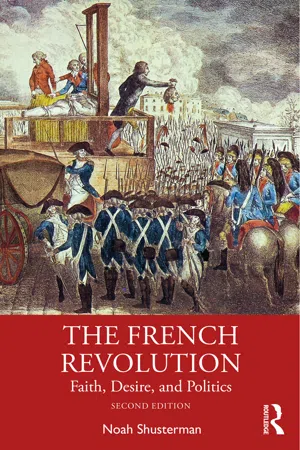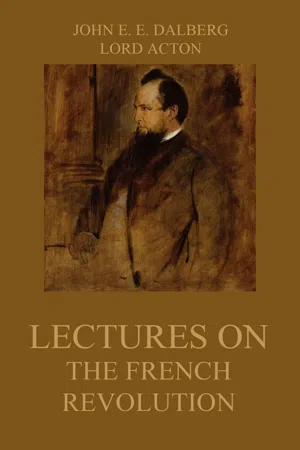History
Storming of the Bastille
The Storming of the Bastille was a pivotal event in the French Revolution on July 14, 1789, when Parisian revolutionaries attacked the Bastille prison, a symbol of royal tyranny. The storming marked the beginning of the revolution and is celebrated as France's National Day. It symbolized the people's defiance against the monarchy and is considered a turning point in the overthrow of the old regime.
Written by Perlego with AI-assistance
Related key terms
Related key terms
1 of 4
Related key terms
1 of 3
6 Key excerpts on "Storming of the Bastille"
- eBook - ePub
The French Revolution
Faith, Desire, and Politics
- Noah Shusterman(Author)
- 2020(Publication Date)
- Routledge(Publisher)
The actual taking of the Bastille was a long, drawn-out affair, full of smoke and gunfire and confusion. Delegates from the city’s electors came several times but were unable to prevent bloodshed and, once the fighting started, they were unable to stop it. For most of the day, the people attacking the Bastille—including those who were members of Paris’s brand new militia – had little in the way of military training. The prison had an outside gate, then an inner courtyard, and then a second round of towers surrounded by a moat. The Parisians were able to get into the inner courtyard quite quickly, only to discover that they were sitting ducks for the Swiss guards firing on them. To the people storming the prison, it felt like a trap: they had been drawn into the courtyard only to be massacred.Figure 2.1 The Storming of the Bastille, July 14, 1789. By the end of the day, reinforcements had come to help the protesters take over the prison. From Révolutions de Paris. © Penn Special Collections.The battle was a stalemate for several hours. The turning point came with the arrival of soldiers from a unit called the French Guard. These soldiers had been stationed in Paris for years; earlier in the summer, though, they had declared their support for the people of Paris and the third estate. On the afternoon of July 14, they arrived at the Bastille, along with several cannons seized that morning from the Hôtel des Invalides. From that point on, the soldiers inside knew that time was running out on them. They could have held out in the hope that reinforcements would come for them too, but it was telling that the first soldiers to arrive as reinforcements came in on the side of the people. Indeed, the allegiance of the area’s soldiers was a major question in July of 1789; the troops stationed outside of Paris might not have been the force of despotism that the people of Paris feared.By the end of the fighting, 83 of the attackers were dead; one had been crushed by the drawbridge, most of the others shot dead after entering the courtyard. Only one of the soldiers defending the Bastille was killed during the fighting. Some would be killed that night by members of the crowd, angry at what they saw as the betrayal of luring them into the courtyard just to shoot their comrades down. De Launey, for his part, surrendered himself to be taken to the Hôtel de Ville. The surrender did not save him. Upon reaching the Hôtel de Ville the crowd succeeded in getting de Launey away from his protectors. One of de Launey’s last actions was to kick one member of the crowd, an unemployed cook named Desnot, in the groin; Desnot did not have to wait long for revenge. After the crowd had killed de Launey, Desnot cut off his head and placed it on a pike, which cheering crowds then paraded throughout the city. This grisly practice (as shown in Figure 2.2 - eBook - ePub
Debunking History
152 Popular Myths Exploded
- Ed Rayner, Ron Stapley(Authors)
- 2009(Publication Date)
- The History Press(Publisher)
6HISTORICAL RE-EVALUATIONSThe Fall of the Bastille, 1789: How Significant Was It?The Bastille was the royal fortress overshadowing the working-class district of Saint-Antoine in eastern Paris in the years down to the French Revolution. Was the existence of the Bastille the threat to the people of Paris that they thought it was, and did the fall of the fortress merit the enormous importance that was attached to it?The Bastille had an exterior court generally open to the public, but it was nevertheless a formidable strongpoint, and could easily be garrisoned against the Parisian citizenry. Built at the end of the fourteenth century as a defence against the English, it had been transformed into a state prison in the reign of Charles VI, and was still spoken of as a sinister place of imprisonment. It had eight round stone towers, each with walls 5 feet thick; its battlements and platforms were supplied with batteries of artillery – nearly thirty heavy 8-pounder cannon and rather more than a dozen smaller pieces; there was a large powder magazine and arsenal, and it was believed (mistakenly, as it happened) to be the depot of a large supply of small arms and ammunition. It was thought in 1789 to house large numbers of prisoners of state. There were known to be deep, dank subterranean dungeons, their walls slimy with filth, and other cells up under the roof where the prisoners froze in winter and stifled in summer.In fact, there were only seven prisoners detained there in July 1789, and the garrison of 82 military pensioners had only recently been reinforced by a draft of 32 extra men from a Swiss regiment. Initially, the defecting soldiers and the mob of citizens who attacked the Bastille on 14 July merely intended to arm themselves with muskets from its magazine and to neutralise the threat from its heavy guns, but the Governor, de Launay, refused their demands, and a lengthy stalemate resulted. They eventually forced open the outside gates, but then declined to enter, thinking that this was a trick by de Launay to get them to come in so that his artillery pieces could mow them down. Before the end of the day, patience had worn thin on both sides. De Launay contemplated firing his whole stock of about 300 barrels of powder, which would have demolished the whole fortress and the greater part of the entire district, but by evening decided to surrender instead with promises of safe conduct. Most of the garrison, nevertheless, were butchered; the Governor himself was hauled out, abused and finally kicked, bayoneted and shot, his head sawn off with a convenient pocket-knife and paraded on a pike. - eBook - ePub
Landscape Painting in Revolutionary France
Liberty's Embrace
- Steven Adams(Author)
- 2019(Publication Date)
- Routledge(Publisher)
Irked by the crown’s refusal to accord it the same rights as the clergy and nobility, the commoners, or the Third Estate, remained in permanent session eventually to become the National Assembly, the Revolution’s first provisional government. 7 Meanwhile, hope for a resolution of the crisis among the National Assembly disappeared after the king’s dismissal of Jacques Necker, the then popular minister of finance who had overseen a radical plan for fiscal reform. 8 Parisians now feared that the city was about to be besieged by royal mercenaries. On the night of 13 July tensions worsened. Situated on the edge of a working-class suburb of Paris well known for its political radicalism, the Bastille was one of several garrisons to be attacked as Parisians went in search of munitions to defend themselves. In one incident on the afternoon of 14 July, botched negotiations between the Bastille’s governor and local citizens caused a deputation to be trapped in the fortress’s interior court and fired upon by its guards. 9 The Bastille’s drawbridge was soon breached after an armed militia, the Gardes françaises, joined the crowd. 10 Indeed, the breach constitutes a significant moment in the Revolution’s history, enabling observers to see the event in terms of a single temporal point. Hubert Robert’s study, made on-site just a week after the siege, shows the fortress in an early stage of its demolition seen from the north-western tower (Figure 2.2). The picture characteristically emphasizes the size of the fortress by setting the building close to the frame and by accentuating its scale through the inclusion of some 50 diminutive demoliseurs on its ramparts. The dark looming presence of the fortress is set against the much lighter tone of the rubble tumbling from its ramparts. The picture stands out in comparison to many examples of Robert’s earlier work - eBook - ePub
- John Emerich Edward Dalberg, Lord Acton(Authors)
- 2016(Publication Date)
- Jazzybee Verlag(Publisher)
The astounding news that Necker heard at "The Three Kings" at Bâle was this. His friends had been disgraced with him, and the chief of the new ministry was Breteuil, who had been the colleague of Calonne and Vergennes, and had managed the affair of the Diamond Necklace. He had directed the policy of those who opposed the National Assembly, holding himself in the twilight, until strong measures and a strong man were called for. He now came forward, and proposed that the nobles should depart in a body, protesting against the methods by which the States-General had been sunk in the National Assembly. In one day he brought round twenty-six of the minority to his views. A few remained, who would make a light day's work for a man of conviction and resource. But resolute as Breteuil was, the Parisian democracy acted with still greater quickness and decision, and with a not less certain aim. On the 12th it became known that Necker had been sent out of the country, and that the armaments were in the hands of men who meant to employ them against the people. Paris was in disorder, but the middle class provided a civic guard for its protection. There were encounters with the troops, and some blood was shed.New men began to appear who represented the rising classes: Camille Desmoulins, a rhetorical journalist, with literary but not political talent, harangued the people in the garden of the Palais Royal; and one of the strong men of history, Danton, showed that he knew how to manage and to direct the masses.The 13th was a day wasted by Government, spent by Paris in busy preparation. Men talked wildly of destroying the Bastille, as a sign that would be understood. Early on July 14 a body of men made their way to the Invalides, and seized 28,000 stand of arms and some cannon. At the other extremity of Paris the ancient fortress of the Bastille towered over the workmen's quarter and commanded the city. Whenever the guns thundered from its lofty battlements, resistance would be over, and the conquered arms would be unavailing.The Bastille not only overshadowed the capital, but it darkened the hearts of men, for it had been notorious for centuries as the instrument and the emblem of tyranny. The captives behind its bars were few and uninteresting; but the wide world knew the horror of its history, the blighted lives, the ruined families, the three thousand dishonoured graves within the precincts, and the common voice called for its destruction as the sign of deliverance. At the elections both nobles and commons demanded that it should be levelled with the ground.As early as the 4th of July Besenval received notice that it would be attacked. He sent a detachment of Swiss, that raised the garrison to one hundred and thirty-eight, and he did no more. During the morning hours, while the invaders of the Invalides were distributing the plundered arms and ammunition, emissaries penetrated into the Bastille, under various pretexts, to observe the defences. One fair-spoken visitor was taken to the top of the dreaded towers, where he saw that the guns with which the embrasures had bristled, which were beyond the range of marksmen, and had Paris at their mercy, were dismantled and could not be fired. - eBook - ePub
The Wars of the French Revolution
1792–1801
- Charles J Esdaile(Author)
- 2018(Publication Date)
- Routledge(Publisher)
63Revealed in the fall of the Bastille was one of the chief pillars of the Revolution at the popular level, namely the rage and despair of the urban poor (it was no coincidence that 14 July 1789 saw bread prices in Paris reach their highest level ever, whilst it is also worth pointing out that Necker was seen by the crowd not so much as the harbinger of a new political order as the harbinger of price controls). However, it was not just on the streets of Paris that the weight of popular ire was felt. In the countryside, the spectacle of a Third Estate dominated by bourgeois proprietors of the sort who were associated with some of the very worst efforts to maximise the profits to be made from the feudal system had not gone unnoticed, and rumours now began to spread of a counter-revolution in the countryside aimed at thwarting the demands of the peasantry. With the harvest approaching, the usual bands of desperate migrant labourers were on the move, and these were now transformed in the popular imagination into mercenary gangs called in to engage in intimidation and murder at the behest of the seigneurs (an alternative and less political explanation is that, given the general dearth, the populace were simply terrified of what the arrival of desperate bands of migrant labourers might mean for their communities, and still another that rural France was in the grip of a collective attack of paranoia brought about via the mass consumption of grain contaminated by ergot, but, even if these ideas have weight, the effect was much the same).64 The result was the grande peur . Starting in Franche-Comté and Gascony – areas that were very different from one another geographically and several hundred miles apart – the countryside was gripped by an extraordinary wave of panic and hysteria that had soon spread virtually from one end of the country to another. Terrified and angry alike, village after village turned on the seigneurs . Stewards and bailiffs, then, were frequently assaulted and many chateaux pillaged and burned to the ground, the trouble going on for many weeks. Weather vanes made in the image of coats of arms were a particular target, along with court houses and the manorial rolls that recorded the precise status of the vileins . Grain supplies, too, were requisitioned and, very occasionally, lands that had once belonged to the commons reclaimed. Finally, here and there, a few unfortunate or particularly provocative seigneurs were even murdered. In one sense, there was nothing new here – peasant revolts, after all, had a long history in France – but never had anything been seen that was quite so widespread or quite so prolonged, nor had there ever been a threat to an entire harvest (in the past, trouble had come at moments in the agricultural years when little work was needed in the fields). Dominated by the representatives of rural property as it was, the National Assembly could not but be quickly drawn into the crisis, and, after much debate, on 4 August it took the only step open to it to save the harvest and defend its collective self-interest, namely the promulgation of the famous declaration announcing the abolition of feudalism.65 Meanwhile, just as in Paris the need to defend the Revolution from the monarchy had led to the formation of a propertied militia, so many villages saw the recruitment of what were in effect peasant equivalents, this being a development in which some observers later professed to see great significance. To quote Jean-Pierre Bial, the son of a prosperous tenant farmer from a small town in the province of Limousin who went on to become a colonel in the grande armée - Louis Adolphe Thiers, Frederick Shoberl(Authors)
- 2016(Publication Date)
- Normanby Press(Publisher)
curés and bishops to the popular election. Here, it was encroaching on the temporal power alone, since it was the King who chose, and the Pope who instituted the ecclesiastical dignitaries. This plan, which was called the civil constitution of the clergy, and which drew upon the Assembly more calumny than anything it had yet done, was, nevertheless, the work of the most pious deputies. It was Camus and other Jansenists, who, desirous of invigorating religion in the state, strove to bring it into harmony with the new laws. It is certain that, justice being everywhere else re-established, it would have been strange had it not also been introduced into the ecclesiastical administration. With the exception of Camus and some others of his stamp, the members of the Assembly, educated in the school of the philosophers, would have treated Christianity like all the other religions admitted into the state, and would not have bestowed a thought upon it. They entertained sentiments which in our present social state it is usual not to combat even when we do not share them. They supported, therefore, the religious and sincerely Christian plan of Camus. The clergy opposed it, alleging that it encroached on the spiritual authority of the Pope, and appealed to Rome. The principal bases of the plan were nevertheless adopted, and immediately presented to the King, who asked for time that he might refer to the high Pontiff. The King, whose enlightened religion recognised the wisdom of this plan, wrote to the Pope, with a sincere desire of obtaining his assent, and thus overthrowing all the objections of the clergy. We shall presently see what intrigues prevented the success of his wishes.The month of July approached. It was nearly a year since the Bastille was taken, since the nation had seized all power, since it had announced its intentions by the Assembly, and executed them itself, or caused them to be executed under its superintendence. The 14th of July was considered as the day which had commenced a new era, and it was resolved that its anniversary should be celebrated with great festivity. The provinces and the towns had already set the example of confederating, to resist with united strength the enemies of the Revolution. The municipality of Paris proposed for the 14th of July a general federation of all France, which should be celebrated in the heart of the capital by the deputies of all the national guards and of all the corps of the army. This plan was hailed with enthusiasm, and immense preparations were made to render the festival worthy of its object.Other nations, as we have seen, had long turned their eyes upon France. The sovereigns began to hate and fear, the people to esteem, us. A party of foreign enthusiasts appeared before the Assembly in the costume of their respective nations. Their spokesman, Anacharsis Clootz, by birth a Prussian, a man of wayward imagination, demanded, in the name of the human race, to be admitted into the Federation.{49}
Index pages curate the most relevant extracts from our library of academic textbooks. They’ve been created using an in-house natural language model (NLM), each adding context and meaning to key research topics.
Explore more topic indexes
Explore more topic indexes
1 of 6
Explore more topic indexes
1 of 4





![The History of the French Revolution Vol I [Illustrated Edition]](https://img.perlego.com/book-covers/3019341/9781787202801_300_450.webp)